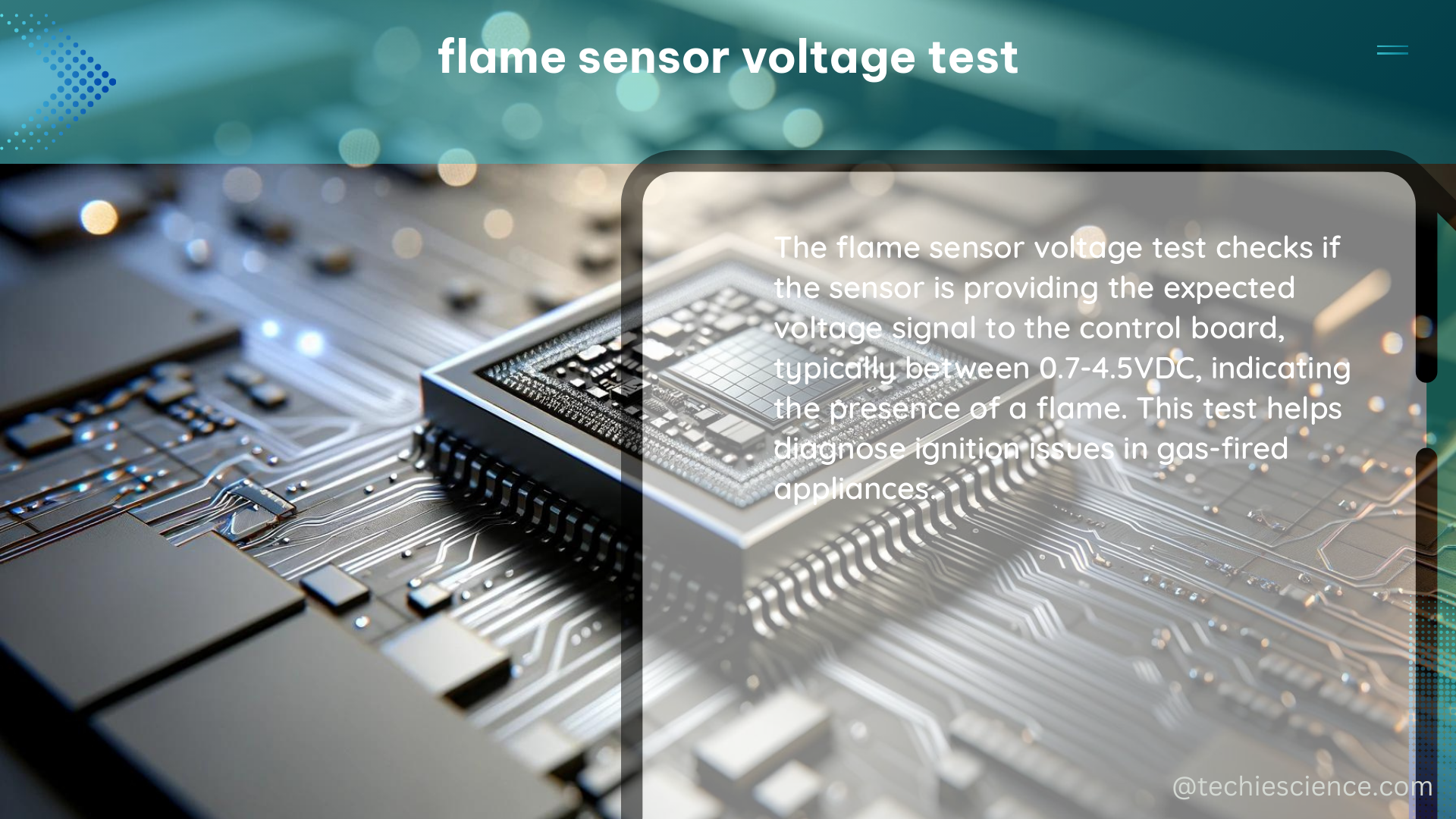The flame sensor voltage test is a critical procedure used to ensure the proper functioning of flame sensors in various applications, such as gas detection in coal mines and wildfire mitigation plans. This test involves measuring the voltage output of the flame sensor, typically in the millivolt (mV) range, to determine if it falls within the specified range indicated by the manufacturer.
Understanding Flame Sensor Voltage Output
Flame sensors are designed to detect the presence of a flame by measuring the voltage output generated by the sensor. This voltage output is directly proportional to the concentration of specific gases in the surrounding atmosphere. The voltage output range can vary depending on the sensor type and manufacturer, but it is typically in the millivolt (mV) range.
For instance, Honeywell’s gas detection sensors, which use a catalytic sensor element, typically have a voltage output range of 37 mV for a specific gas concentration in the surrounding atmosphere. This output voltage is measured using a 3-wire mV bridge circuit, which converts the resistance change in the platinum coil of the sensing element into a measurable voltage signal.
Flame Sensors in Wildfire Mitigation Plans

In the context of wildfire mitigation plans, flame sensors are used to detect and monitor the potential for wildfires in high fire threat districts (HFTDs). These sensors are calibrated to detect specific gas concentrations, such as:
- Carbon monoxide (CO)
- Hydrogen cyanide (HCN)
- Hydrogen fluoride (HF)
- Hydrogen bromide (HBr)
- Hydrogen chloride (HCl)
- Hydrogen sulfide (H2S)
- Unburned hydrocarbons
- Aromatics
These gases are responsible for fire toxicity and can pose a significant threat to firefighters and the surrounding community. The sensors provide real-time data on gas concentrations, which can be used to assess fire toxicity and hazard risk, as well as to quantify and record toxic gas exposures to firefighters for long-term health monitoring.
Performing the Flame Sensor Voltage Test
When performing a flame sensor voltage test, it is essential to follow the manufacturer’s specifications and guidelines for calibration and maintenance. This includes:
- Checking the Sensor’s Zero and Span Potentiometers: Ensure that the voltage output matches the gas mixture concentration by adjusting the zero and span potentiometers on the sensor.
- Verifying the Sensor’s Mounting: Confirm that the sensor is mounted in a strong metal housing behind a flame arrestor to prevent the propagation of any flame to the outside atmosphere.
- Measuring the Voltage Output: Use a multimeter or a dedicated flame sensor voltage test kit to measure the voltage output of the flame sensor. Compare the measured voltage to the manufacturer’s specified range.
- Documenting the Test Results: Record the measured voltage output, the date of the test, and any adjustments made to the sensor’s potentiometers. This information can be used for future reference and troubleshooting.
Factors Affecting Flame Sensor Voltage Output
Several factors can influence the voltage output of a flame sensor, including:
- Gas Concentration: The voltage output of the flame sensor is directly proportional to the concentration of the target gases in the surrounding atmosphere.
- Sensor Aging: Over time, the sensing element in the flame sensor can degrade, leading to changes in the voltage output.
- Environmental Conditions: Temperature, humidity, and other environmental factors can affect the sensor’s performance and voltage output.
- Sensor Contamination: Exposure to dust, dirt, or other contaminants can interfere with the sensor’s ability to accurately measure the gas concentration.
Maintaining Flame Sensor Accuracy
To ensure the continued accuracy and reliability of flame sensors, it is essential to follow the manufacturer’s recommended maintenance and calibration procedures. This may include:
- Periodic calibration using certified gas mixtures
- Cleaning the sensor’s housing and flame arrestor
- Replacing the sensor element at the recommended intervals
- Monitoring the sensor’s voltage output and adjusting the zero and span potentiometers as needed
By following these best practices, you can ensure that your flame sensors are providing accurate and reliable data, which is crucial for effective wildfire mitigation and gas detection in hazardous environments.
Conclusion
The flame sensor voltage test is a critical procedure for ensuring the proper functioning of flame sensors in various applications. By understanding the voltage output range, the factors that can affect sensor performance, and the importance of following manufacturer guidelines, you can ensure that your flame sensors are providing accurate and reliable data to support your safety and monitoring needs.
References:
- Honeywell Analytics. (2013). Honeywell Gas Detection. Retrieved from https://www.honeywellanalytics.com/~/media/honeywell-analytics/documents/english/11296_gas-book_v5_0413_lr_en.pdf?la=en
- Southern California Edison. (2020). 2020‐2022 Wildfire Mitigation Plan. Retrieved from https://www.sce.com/sites/default/files/AEM/SCE%202020-2022%20Wildfire%20Mitigation%20Plan.pdf
- University of California, Los Angeles. (2022). Fighting Fire Toxicity: Improving Safety and Heath via Novel Optical Sensors. Retrieved from https://www.fema.gov/sites/default/files/documents/fema_gpd-rd-abstracts-fy-2005-fy-2022-november-2023-original-508.pdf

The lambdageeks.com Core SME Team is a group of experienced subject matter experts from diverse scientific and technical fields including Physics, Chemistry, Technology,Electronics & Electrical Engineering, Automotive, Mechanical Engineering. Our team collaborates to create high-quality, well-researched articles on a wide range of science and technology topics for the lambdageeks.com website.
All Our Senior SME are having more than 7 Years of experience in the respective fields . They are either Working Industry Professionals or assocaited With different Universities. Refer Our Authors Page to get to know About our Core SMEs.